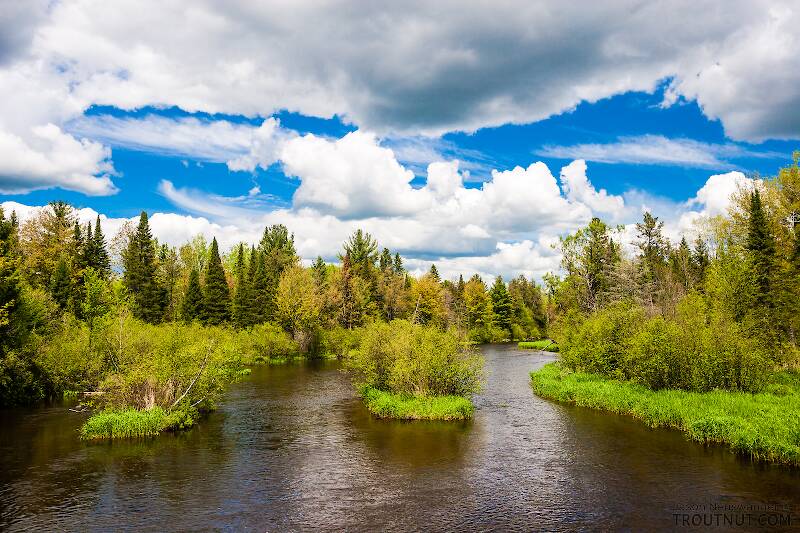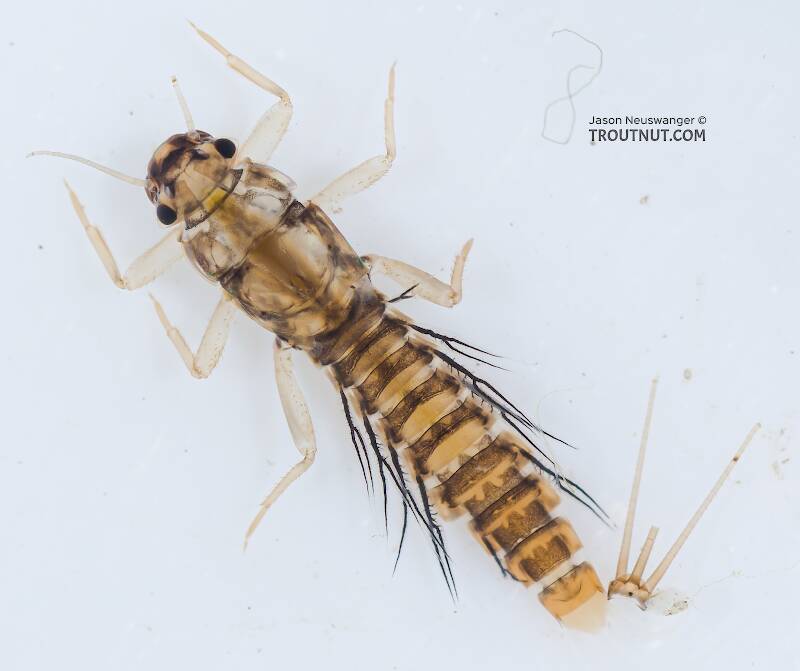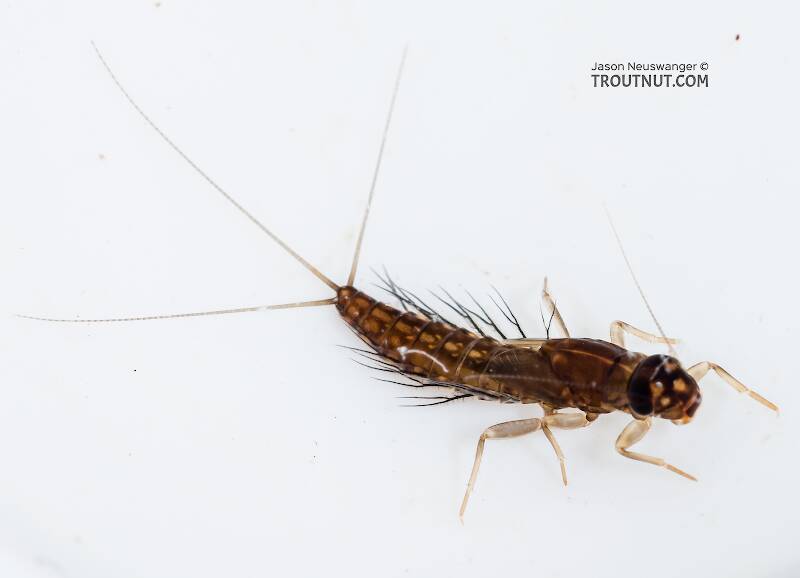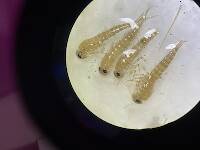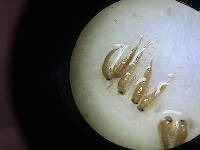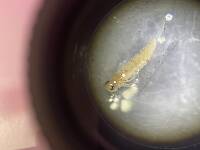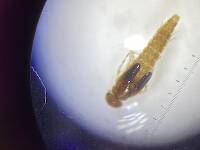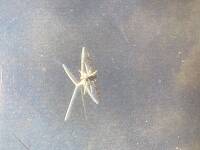
Salmonflies
Pteronarcys californica
The giant Salmonflies of the Western mountains are legendary for their proclivity to elicit consistent dry-fly action and ferocious strikes.
Featured on the forum

This is an interesting one. Following the keys in Merritt R.W., Cummins, K.W., and Berg, M.B. (2019) and Jacobus et al. (2014), it keys clearly to Ephemerella. Jacobus et al provide a key to species, but some of the characteristics are tricky to interpret without illustrations. If I didn't make any mistakes, this one keys to Ephemerella mucronata, which has not previously been reported any closer to here than Montana and Alberta. The main character seems to fit well: "Abdominal terga with prominent, paired, subparallel, spiculate ridges." Several illustrations or descriptions of this holarctic species from the US and Europe seem to match, including the body length, tarsal claws and denticles, labial palp, and gill shapes. These sources include including Richard Allen's original description of this species in North America under the now-defunct name E. moffatae in Allen RK (1977) and the figures in this description of the species in Italy.

Troutnut is a project started in 2003 by salmonid ecologist Jason "Troutnut" Neuswanger to help anglers and
fly tyers unabashedly embrace the entomological side of the sport. Learn more about Troutnut or
support the project for an enhanced experience here.
This topic is about the Mayfly Family Leptophlebiidae
The champions of this family are Leptophlebia and Paraleptophlebia, along with the relatively newly-defined genus Neoleptophlebia containing several important species that were once in Paraleptophlebia. The large mayflies of Leptophlebia are on the water sporadically for a long time. The Paraleptophlebia and Neoleptophlebia flies are smaller but come in much more concentrated numbers.Leptophlebiidae also contains several genera and species which are never mentioned in fly-fishing literature, either because they are too rare or because they require water too warm for trout.
Example specimens
JasonM on Mar 6, 2010March 6th, 2010, 7:18 pm EST
I live in Arizona and I have a question...
Over the past several years I have witnessed a spectacular emergence of mayflies on a stream I frequent in the Mogollon Rim area of Arizona. The stream is a tributary to the Little Colorado River drainage.
The adults seem to emerge on exposed midstream rocks of along the shoreline. The duns can be very dense, sometimes every rock along shore has one drying its wings beforetaking flight They are a dark greyish brown bodied, dark grey winged adult, I have named them MOCHA DUNS for lack of knowledge of their true identity. Three tails on the adult as well. They are pretty big....a big size 14 to 16. I have captured several specimens as larvae that I believe are the same species as the ones I have observed as adults. The larvae have prominent gills. 3 long split tails, similar size and color, hign densities along shore and in the shallows, etc. I'm 90% sure that they are Leptophlebiidae. But I don't know the species, yet.
The trout don't seem to key in on the adults...since they emerge on land...but I have experienced some incredible fishing during very windy days while the hatch is on. The nymphs appear to have trouble holding on to the substrates they are trying to emerge on. I have witessed several swimming to a streamside cobble, grasping the rock for a moment, only to be swepped back into the water by small, lapping waves being caused by the wind. They try repeatedly but seem to get exhausted pretty quickly. They must be easy picking for fish cruising along the bank, as I have great success fishing imitations along the shore with short twitches. I have rarely seen duns on the surface of the stream, even on the windiest of days. They seem to emerge late morning to early afternoon.
CAN ANYBODY SUGGEST WHAT SPECIES THIS MAYBE. I don't have a scope or any literature anymore. I have experience with ID'ing but not lately
Any help would be appreciated by this inquisitive angler. Thanks
Jason Mszaros
The Drag Free School of Fly Fishing
928-273-9445
Over the past several years I have witnessed a spectacular emergence of mayflies on a stream I frequent in the Mogollon Rim area of Arizona. The stream is a tributary to the Little Colorado River drainage.
The adults seem to emerge on exposed midstream rocks of along the shoreline. The duns can be very dense, sometimes every rock along shore has one drying its wings beforetaking flight They are a dark greyish brown bodied, dark grey winged adult, I have named them MOCHA DUNS for lack of knowledge of their true identity. Three tails on the adult as well. They are pretty big....a big size 14 to 16. I have captured several specimens as larvae that I believe are the same species as the ones I have observed as adults. The larvae have prominent gills. 3 long split tails, similar size and color, hign densities along shore and in the shallows, etc. I'm 90% sure that they are Leptophlebiidae. But I don't know the species, yet.
The trout don't seem to key in on the adults...since they emerge on land...but I have experienced some incredible fishing during very windy days while the hatch is on. The nymphs appear to have trouble holding on to the substrates they are trying to emerge on. I have witessed several swimming to a streamside cobble, grasping the rock for a moment, only to be swepped back into the water by small, lapping waves being caused by the wind. They try repeatedly but seem to get exhausted pretty quickly. They must be easy picking for fish cruising along the bank, as I have great success fishing imitations along the shore with short twitches. I have rarely seen duns on the surface of the stream, even on the windiest of days. They seem to emerge late morning to early afternoon.
CAN ANYBODY SUGGEST WHAT SPECIES THIS MAYBE. I don't have a scope or any literature anymore. I have experience with ID'ing but not lately
Any help would be appreciated by this inquisitive angler. Thanks
Jason Mszaros
The Drag Free School of Fly Fishing
928-273-9445
howdy
Taxon on Mar 6, 2010March 6th, 2010, 7:45 pm EST
JasonM-
What month of the year does this emergence seem to peak?
If it's some time between mid-June and mid-July, my guess would be Paraleptophlebia memorialis.
Here is a detailed description:
Family: Leptophlebiidae
Scientific name: Paraleptophlebia memorialis
Previously know as: Leptophlebia memorialis, Leptophlebia pallipes (in part), Paraleptophlebia pallipes
Common name: Mahogany Dun, etc.
Locality: W
CAN Regions: NW
MEX Regions: SW
USA Regions: NW, SW
Cent. Amer. Countries:
CAN Provinces: AB, BC.
MEX States: BN.
USA States: AZ, CA, CO, ID, NM, OR, SD, UT, WA
Habitat:
Voltinism:
Emergence (begin) date: mid-Jun
Emergence (end) date: early-Aug
Emergence time of day: afternoon
Spinner fall time of day:
Nymph minimum length: 6 mm.
Nymph maximum length: 7 mm.
Nymph identification keys: gill fork 1/3 from base; abdominal spines on segment 8 & 9; tergites dark, each w/three light dots, a medium-sized one on center-line, and a small-sized one forward on each side of center-line
Nymph body description:
Nymph legs:
Nymph gills: gill/filament length ratio (1:3), trachael branching: (absent)
Nymph tusks: absent
Nymph tails: 3,
Dun minimum length: 6 mm.
Dun maximum length: 8 mm.
Dun identification keys:
Dun body description: brown to dark reddish brown
Dun wings: medium gray, hind wings w/o costal angulation
Dun legs: brown
Dun tails: 3, light to dark brown
Spinner minimum length: 7 mm.
Spinner maximum length: 7 mm.
Spinner identification keys: male claspers w/3 joints
Spinner body description: abdomen whitish
Spinner wings: hyaline, fore wing with attached intercalaries, hind wing w/o costal angulation
Spinner legs:
Spinner tails: 3,
What month of the year does this emergence seem to peak?
If it's some time between mid-June and mid-July, my guess would be Paraleptophlebia memorialis.
Here is a detailed description:
Family: Leptophlebiidae
Scientific name: Paraleptophlebia memorialis
Previously know as: Leptophlebia memorialis, Leptophlebia pallipes (in part), Paraleptophlebia pallipes
Common name: Mahogany Dun, etc.
Locality: W
CAN Regions: NW
MEX Regions: SW
USA Regions: NW, SW
Cent. Amer. Countries:
CAN Provinces: AB, BC.
MEX States: BN.
USA States: AZ, CA, CO, ID, NM, OR, SD, UT, WA
Habitat:
Voltinism:
Emergence (begin) date: mid-Jun
Emergence (end) date: early-Aug
Emergence time of day: afternoon
Spinner fall time of day:
Nymph minimum length: 6 mm.
Nymph maximum length: 7 mm.
Nymph identification keys: gill fork 1/3 from base; abdominal spines on segment 8 & 9; tergites dark, each w/three light dots, a medium-sized one on center-line, and a small-sized one forward on each side of center-line
Nymph body description:
Nymph legs:
Nymph gills: gill/filament length ratio (1:3), trachael branching: (absent)
Nymph tusks: absent
Nymph tails: 3,
Dun minimum length: 6 mm.
Dun maximum length: 8 mm.
Dun identification keys:
Dun body description: brown to dark reddish brown
Dun wings: medium gray, hind wings w/o costal angulation
Dun legs: brown
Dun tails: 3, light to dark brown
Spinner minimum length: 7 mm.
Spinner maximum length: 7 mm.
Spinner identification keys: male claspers w/3 joints
Spinner body description: abdomen whitish
Spinner wings: hyaline, fore wing with attached intercalaries, hind wing w/o costal angulation
Spinner legs:
Spinner tails: 3,
Quick Reply
Related Discussions
Topic
Replies
Last Reply
1
Sep 9, 2008
by GONZO
by GONZO
0
May 3, 2007
by Troutnut
by Troutnut

